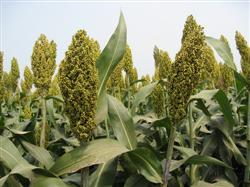Sorghum planting: how to control sorghum smut?

Loose smut often occurs in planting sorghum. How to prevent and cure sorghum smut? Please introduce the method of sorghum loose smut in the seedling stage, the symptom is not very obvious, but the plant is a little shorter, the color is slightly dark, and the heading is earlier. After heading, the rachis and branches were intact, the glume protection increased significantly, and the whole panicle grain turned into an oblong gall with a layer of white film and a large amount of black powder. After the gall matured, the film ruptured and the black powder dispersed, revealing the black residue and glume protection. Some of the seeds become fungus galls, and the rest are not fruiting. The disease is mainly carried by soil and seeds, but mainly by seeds. The pathogen can survive outdoors for a year, and its pathogenicity decreases after overwintering in the soil. After sowing, the pathogen invaded the sorghum seedlings from the wound, epidermis and young roots and spread to the growing point of sorghum. During heading, the pathogen entered the ear, destroyed the ovary and formed galls. The occurrence of the disease is related to the resistance of varieties, the number of bacteria in soil and seeds, and the unearthed speed of seedlings. Sorghum loose smut can be controlled with reference to the following methods: first, select disease-resistant varieties. Farm varieties are generally not resistant to disease. The main resistant or immune varieties are introduced foreign varieties, such as Fanong No. 1, Meihong, whitening, precocious Hengali, Hengali and so on. Second, timely sowing and improving sowing quality, early sowing, dry soil, poor quality of soil preparation and overthick soil cover will prolong the time of seedling emergence, increase the chance of infection and aggravate the disease. Therefore, it is generally necessary to sow as late as possible under the condition of maturity, and the soil moisture before sowing is suitable, the soil preparation is fine, and the soil covering depth is suitable, so as to ensure early emergence and strong seedlings, shorten the infection time of buds and reduce the occurrence of diseases. Due to the fact that the pathogen can only survive in the soil for one year, proper rotation in the disease area can effectively reduce the damage. Fourth, remove the diseased plants and reduce the source of bacteria in the following year. Fifth, seed treatment is mainly seed dressing to eliminate germs on the seed and in the rhizosphere soil around the seed. ⑴ 50% verapamil powder 350g seed dressing 50kg, or 16% verapamil EC stuffy seed (same as sorghum head smut). ⑵ 50% and 70% pentachloronitrobenzene powder 300g seed dressing 50kg. ⑶ 50g carbendazim wettable powder 350g seed dressing 50kg. ⑷ 50% carbendazim wettable powder 350g seed dressing 50kg. In addition, seed dressing with antibiotic bacteria 769,775 and 3013 has a better effect on disease control. Click to get more sorghum planting technology click to get more grain planting technology
- Prev

Sorghum planting: how to control sorghum anthracnose?
How to control anthracnose by planting sorghum? Please introduce the method of sorghum anthracnose is a common disease of sorghum, after the plant is susceptible, the leaves appear disease spots, the function is reduced, affecting fruiting and filling. Production is generally reduced by 10%, and in severe cases, it can be reduced by more than 25%. Sorghum anthracnose can be controlled by referring to the following methods: ①.
- Next

Cotton planting: how to choose and buy cotton seeds?
How to choose and buy cotton seeds? Please introduce the correct selection and purchase of cotton seeds that should be paid attention to. We can refer to the following methods: for the correct selection of varieties, we should choose the national examination recommended by the local agricultural department or the main recommended variety approved by the province as the seed for production. Not when you buy it.
Related
- The first cup of black tea in spring, the flavor and history of tea gardens in Kenya, Africa
- The computer can not only choose potatoes, but also grow tea rice. AI will grow winter oolong tea champion.
- It is not only the inflated tea bitten by insects, but also engraved with the four seasons tea in Beipu.
- The Oriental Beauty Tea Festival in Zhuxian County takes the stage at the weekend to experience the plus-size feast of oil tea.
- & quot; Oriental Beauty Tea & Exploration of Emei in Hsinchu, the hometown of quot;
- The new variety of strawberry "Tainong 1" dessert is the first choice with mellow aroma. Crimson gorgeous
- History of Tea in Taiwan: from Wild Inner Mountain to Export Tea Garden
- Two types of Taiwan Oriental Beauty Black Tea won the British three-Star Award for Childhood Tea Xiang Zhang Jiaqi changed from pilot to champion tea maker.
- Banana species and varieties: the planting history of Taiwan Xianren banana and dwarf banana is long, is banana disease resistant?
- Coffee planting Technology: Qianjie Coffee from Seedling to harvesting

